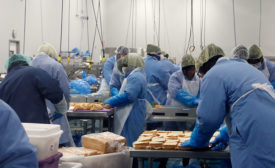Articles by Wayne Labs
Reducing environmental chemicals
This relatively new family of biopesticides shows promise for the future and is already used alone and in combination with chemical treatments
Read More
Odor control
Psst: Do you have an odor problem?
Even too much of a typically pleasant odor at home—like baking bread—might not be so pleasantly received at industrial levels
June 11, 2021
Engineering R&D
Exploring SideDrive's unique conveyor configuration
When you think of conveyors, you think of conventional pulley-driven or drum-motor powered designs, however, this system uses small motors geared to the belt’s edge.
June 9, 2021
Cyberattacks
Ransomware attack hits JBS, shutting down operations
Thanks to backups and security precautions in place, the company is recovering
June 2, 2021
Plant Construction Survey
Food Engineering’s 44th annual plant construction survey
Pandemic spawns solutions to supply chain and processing woes
May 25, 2021
System Integration
When automation projects need special attention and ASAP delivery, a one-stop SI delivers
Two uniquely different cases show how an adept system integrator can build customized equipment and lines not available off the shelf
May 17, 2021
Automation Trends
Automation in the time of COVID-19: An A&E/C perspective
COVID-19 has demonstrated even more greatly the benefits of automation—from process to packaging to the distribution center
May 14, 2021
Coping with COVID-19
COVID-19 review: Shorter supply chains and reliance on 3D tools for remote walk-throughs
While supply chain problems were plentiful, this A&E firm was able to keep food industry projects going with high-tech devices
May 13, 2021
Integrating islands of automation
Integrating automation throughout the process offers advantages to food and beverage processors
May 5, 2021
Manufacturing News
Cyberattacks: What food processors won’t talk about
Sharing information about cyberattacks can help strengthen the entire industry
May 3, 2021
Elevate your expertise in food engineering with unparalleled insights and connections.
Get the latest industry updates tailored your way.
JOIN TODAY!Copyright ©2024. All Rights Reserved BNP Media.
Design, CMS, Hosting & Web Development :: ePublishing










